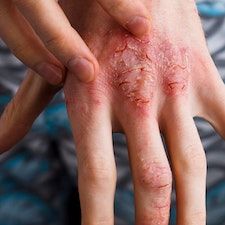ILC2 Activity, Stronger Eosinophilic Skin Inflammation for Infants with Atopic Dermatitis
New data from the 2023 AAAAI conference showed that the mice with atopic dermatitis used in the study had different responses to ILC2 activity depending on their age.

In recent data shown at the American Academy of Allergy, Asthma & Immunology (AAAAI) 2023 Annual Meeting in San Antonio, TX, group 2 innate lymphoid cells (ILC2) activity was found to induce stronger eosinophilic skin inflammation for infants with atopic dermatitis (AD) over adults.1
This new research into AD pathogenesis was led by Hiroki Sugiyama, MD, from the National Research Institute for Child Health and Development in Japan.
AD is a common chronic skin disorder that affects people of all different ages. The condition is characterized by the infiltration of immune cells, the subsequent release of various chemokines, cytokines, and other inflammatory mediators, and the promotion of an inflammatory response which damages the skin barrier.
While the skin condition is widespread, its pathogenesis has been shown to differ between infants and adults. In order to better examine this distinction, Sugiyama and colleagues performed in vivo experiments in their research using a mouse model of AD.
Background and Results
The study involved topical application of a vitamin D analogue (calcipotriol; MC903) or vehicle to C57BL6 wild-type mice’s ears at either 2 weeks or 9 weeks of age (infant and adult mice, respectively).
Skin inflammation was later evaluated through the measurement of ear thickness and through histology.
The immune cells in the mice’s ear tissue were then assessed by using flow cytometry, and the expression of cytokines was assessed by using ELISA and by quantitative PCR.
The results of the study indicated that the eosinophil number, ear thickness, ILC2s, and expression of type 2 cytokines in the ears were all substantially greater for infant mice treated with MC903 versus adult mice.
However, expression of these inflammation regulators—such as thymic stromal lymphopoietin (TSLP) and interleukin-33 (IL-33)—were greater in adult mice rather than infants. Additionally, type 2 cytokine production by ILC2s was found to be significantly higher for the infant mice.
The study concluded that T2 inflammation had greater severity in infant mice versus adult mice, which the investigators attribute to, in all likelihood, the infant mice having greater ILC2 activity.
The data can help to improve general understanding of AD’s pathogenesis for various age groups and it may have implications for therapeutic AD intervention developments in the future.
The results of this research presented at AAAAI suggest that a different approach may be needed to treat AD in infants than in adults, as the underlying mechanisms appear to differ.
References
- Sugiyama H., et al. ILC2 activity in infants induces stronger eosinophilic skin inflammation than in adult in an atopic dermatitis mouse model. The Journal of Allergy and Clinical Immunology. https://www.jacionline.org/article/S0091-6749(22)01663-3/fulltext. Accessed February 25, 2023.